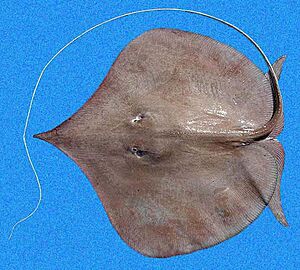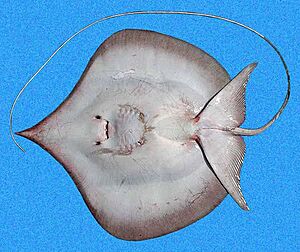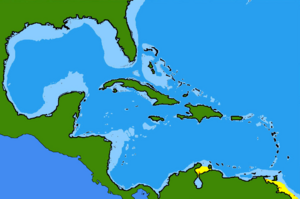Sharpsnout stingray facts for kids
Quick facts for kids Sharpsnout stingray |
|
|---|---|
 |
|
 |
|
| Conservation status | |
| Scientific classification | |
| Genus: |
Fontitrygon
|
| Species: |
geijskesi
|
 |
|
| Synonyms | |
|
Dasyatis geijskesi |
|
The sharpsnout stingray is also known as the wingfin stingray. Its scientific name is Fontitrygon geijskesi. This type of stingray lives in the ocean waters near Venezuela and northern Brazil.
You can find sharpsnout stingrays in shallow, brackish water, which is a mix of fresh and salt water. They move closer to the coast during the dry season. When the rainy season comes, they swim further away from the coast. These stingrays are usually about 70 centimeters (28 inches) wide. They are easy to spot because of their long, pointy snout and long, pointed pelvic fins. Sharpsnout stingrays are dark brown.
They eat small animals that live on the ocean floor. Female sharpsnout stingrays give birth to one to three babies each year. This stingray is naturally rare and doesn't have many babies. Because of this, and because they are caught by fishers, the International Union for Conservation of Nature (IUCN) says they are critically endangered. This means they are at a very high risk of disappearing forever.
Contents
About the Sharpsnout Stingray
A Dutch scientist named Marinus Boeseman first described the sharpsnout stingray in 1948. He wrote about it in a science magazine called Zoologische Mededelingen. He studied a young male stingray caught near Suriname.
Scientists have studied the sharpsnout stingray to understand its family tree. They found that it is closely related to the longnose stingray. These two stingrays are part of a larger group that includes other stingrays like the pale-edged stingray and the pearl stingray.
Where Sharpsnout Stingrays Live
The sharpsnout stingray is not a very common type of stingray. It lives in the shallow, brackish waters along the northeastern coast of South America. You can find them from Venezuela and Trinidad and Tobago down to northern Brazil. Many of them live in the estuary area where the Amazon River flows into the ocean.
They prefer muddy places that are about 5 to 25 meters (16 to 82 feet) deep. The water in these areas often has low visibility, meaning it's hard to see through. Sharpsnout stingrays move each year depending on how salty the water is. They go into coastal bays, like Marajó Bay, during the rainy season. Then, they move to deeper offshore waters during the dry season.
Sharpsnout Stingray Appearance
The body of the sharpsnout stingray is flat and round, like a disc. It is about as wide as it is long. The front edges of its body curve inward. Its snout is very long and pointy, making up a big part of its body width.
Its eyes are tiny, but the spiracles (breathing holes behind the eyes) are much larger. It has a small flap of skin between its nostrils. The mouth is slightly curved in the middle. Both the upper and lower jaws have many rows of blunt teeth, arranged in a pattern.
The pelvic fins of this stingray are special. They are more than twice as long as they are wide. They have a wavy back edge and end in a sharp point. Sometimes, these fins extend past the main body disc. The tail is long and thin, like a whip. It is more than twice as long as the body disc. The tail has one or two jagged spines on top. Behind the spines, there's a small ridge on top and a fin fold underneath.
A line of small bumps runs along the middle of its back, from behind the eyes to the base of the tail. There are larger bumps in a central row and on its "shoulders." More cone-shaped bumps are scattered over the top of the tail past the spines. The stingray is a solid brown color on top. Its underside is white, getting darker towards the edges of its body. Most sharpsnout stingrays are about 70 centimeters (28 inches) wide. However, some have been found to be as wide as 1.5 meters (5 feet).
Sharpsnout Stingray Diet and Life Cycle
The sharpsnout stingray eats small animals that burrow in the sand or mud. These include worms, crustaceans (like crabs), and molluscs (like clams). It digs them out of the ground and grinds them up with its flat teeth.
Like other stingrays, the sharpsnout stingray gives birth to live young. The babies grow inside the mother without a placenta. Females give birth to one to three babies each year. The yearly movements of this stingray might be related to reproduction. Many females found near the coast are newly pregnant. Younger stingrays have tails that are longer in proportion to their body than adult stingrays. A young stingray's tail can be up to three times as long as its body disc.
Sharpsnout Stingray and Humans
The sharpsnout stingray has sharp, venomous spines on its tail. These can be dangerous to humans if stepped on. Fishers catch this stingray using hooks and lines or in nets. People who fish for food eat them, but they are not a favorite because their meat is a dark reddish color.
Sharpsnout stingrays are also often caught by accident. This happens when fishers are trying to catch other fish, like large catfish, in the Amazon estuary. There is also growing interest in using stingrays for minced fish products. This could mean even more fishing pressure on this species in the future.
Because of these threats and the fact that they reproduce slowly, the International Union for Conservation of Nature (IUCN) has listed the sharpsnout stingray as Critically Endangered. This means it faces a very high risk of becoming extinct in the wild.


